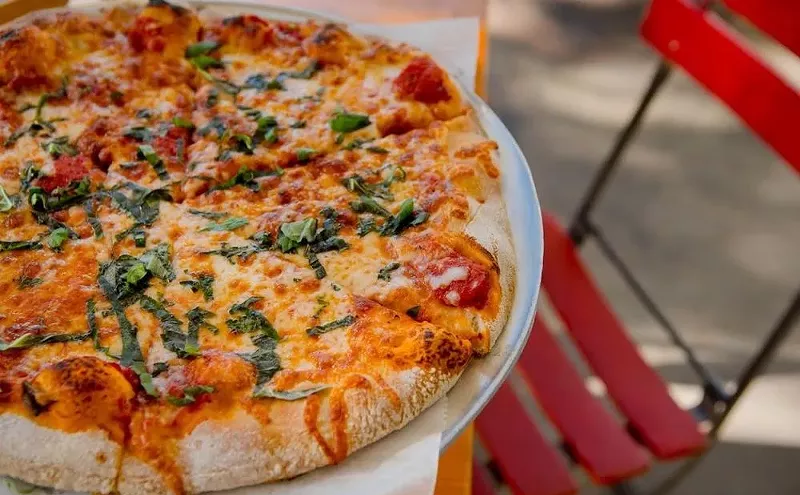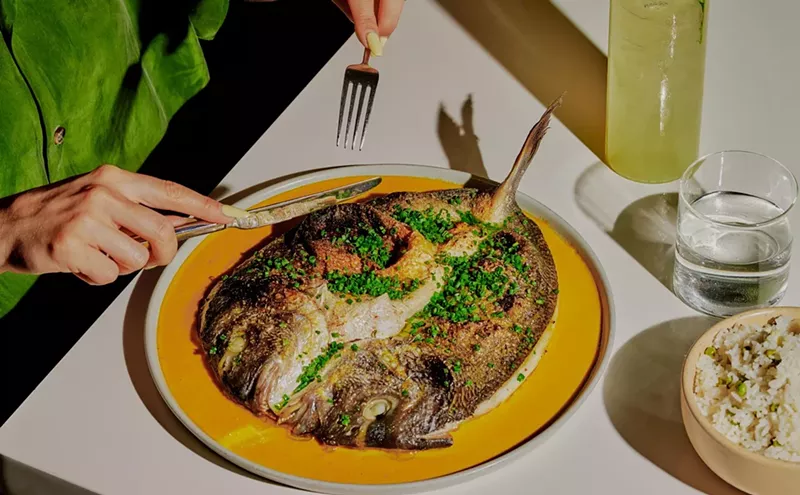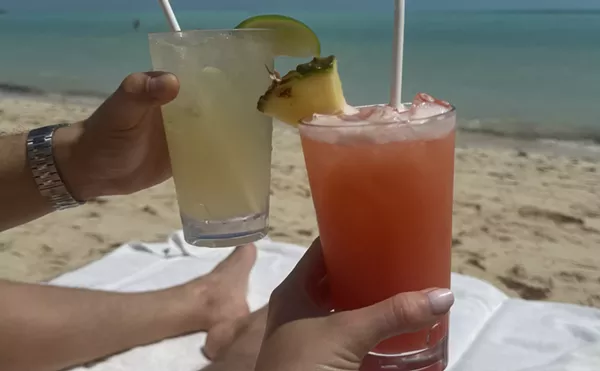I hold El Nino responsible for disrupting Miamians' lives in one significant way: dining outdoors. Let's face it -- balmy winter and early spring nights are a big boon for South Florida residents, the kind of thing we like to brag about to family and friends trapped in colder climes. Nothing is more alluring than delicious flavors on the palate paired with salt-scented breezes on the cheek. But El Nino's nonseasonal storms have often driven us inside restaurants (much the same way the mosquito invasion of spring 1997 did). But what happens when a restaurant doesn't have an interior?
Such is the case with the year-old Tapas Under the Trees, located in the Fontainebleau Hilton in Miami Beach -- or, more specifically, adjacent to the hotel's pool. Open only for dinner, the place's decor depends entirely on the weather. The ceiling could be a picturesque Monet: soft, midnight blue broken by a blurry canopy of leaves and branches. Or it could be a menacing Turner: stormy dark gray punctuated by slashes of orange light. This past winter's abundance of Turners threatened to rust the pink-and-white patio furniture and warp flamenco guitarist David Fernando's instrument (which would be a shame, given that the CD player management uses when he's not playing tends to skip). And the few times I called in anticipation of dining there, Tapas Under the Trees was nonoperational owing to rain. But as spring settles in and weather conditions stabilize, the eatery seems once again to be a viable dining option. (Until summer, that is, but at least then the storms are more predictable.)
As its name suggests, the restaurant serves tapas -- appetizer-size dishes of Spanish origin. And while many of the twenty-plus offerings are international in scope, several have their roots firmly planted in Spain. Champinones al ajillo, mushrooms sauteed in garlic, and gambas al ajillo, cold-water shrimp prepared the same way, are traditional Spanish starters. As was gazpacho Andalucia ($4.00). The chilled puree of tomatoes, cucumbers, and onions was a smooth and tangy blend, if a bit too heavy on the onions.
We passed over tapa de la casa, another cold option comprising manchego cheese, serrano ham, chorizo sausages, and marinated olive salad, preferring our sausages hot. A chorizo-potato frittata fit the bill. Bits of the pork sausage were scattered over a crisp, shredded potato pancake; given the frittata appellation, we'd expected more of an omelet. The pan-fried cake was garnished with sour cream and chives and roasted scallions that were a little on the burnt side.
Grilled chorizo sausages were simpler and a bit more authentic. Split lengthwise, the rosy meat was skewered and served with a red bell pepper sauce for dipping. A twenty-ounce pitcher of ruby-hue sangria ($12.00), poured tableside over fresh fruit and ice, washed down the piquant sausages nicely. Several tapas exhibit Caribbean influences, including West Indian marinated Florida swordfish, grilled shrimp marinated in Scotch bonnet peppers and key limes, and baked green plantains topped with crabmeat. Bahamian cracked conch salad, a cold appetizer, was served in half a coconut -- a pleasant innovation. The zesty salad was beautifully jewel-toned, brimming with chopped red tomatoes and green peppers, but the strips of slightly chewy white conch were too few.
Black bean soup lacked beans, which means the thin, insipid broth also lacked the earthy character we expect from legumes. Salt and spices were also MIA. The touted accompaniments of pico de gallo and cilantro sour cream, which might have souped up the brew, were forgotten; the waiter brought plain sour cream instead. A Jamaican beef empanada ($4.50) was savory enough to make us forget about the bean broth. A golden pastry crust encased the spiced ground beef, which spilled out of its buttery confinement when cut. A tropical fruit chutney -- papaya and kiwi -- sparkled next to the turnover.
Latin America checks in on the menu via two items: grilled breast of chicken marinated in chimichurri and garnished with tomatillo relish, and a grilled tenderloin of beef with roasted corn and ancho chili salsa. The latter was generous for a tapa -- three medallions of juicy, medium-rare beef served on skewers. Unfortunately the meat was oddly bland, and the charred kernels of corn and weak salsa didn't improve the flavor.
Finally, there was a Mediterranean touch. A succulent, seared fillet of grilled yellowfin tuna ($7.00) was presented on focaccia. Black olive tapenade, whole black and green olives, a sun-dried tomato spread, and pickled sliced white onions accented the fish, which was quite good on its own. Smoked salmon dip, on the other hand, needed a boost. The goat-cheese-based spread was too thick for the brittle lavash (Middle Eastern crackers) served with it, and the shiitake mushrooms mixed throughout were simply weird. We thought this stuff needed a bagel.
Still hungry? We kind of were, and ordered dessert. A key lime tart was tangy if a bit dense in the crust area. Cappuccino-chocolate torte was flourless, silky, and rich. Like everything else here, sweets were less than huge in size, and hearty appetites will want to search elsewhere. But for light grazing and sangria-sipping on a perfect spring evening when El Nino has forgotten to harass us, Tapas Under the Trees is predictably pleasant.
Dining at the sixteen-month-old Red Fish Grill -- located in Matheson Hammock, a popular family beachside park in Coral Gables that closes at sunset -- is both more and less problematic. Like Tapas Under the Trees, the grill is open only for dinner. Park officials mark the route to the restaurant with pylons. We still got lost. At first we also couldn't find the restrooms, probably because they're located in a building separate from the restaurant. Once we got there, we wished we hadn't. Red Fish patrons use the same facilities that beachgoers have abused all day. My advice: Go before you leave home, and avoid drinking the water.
Red Fish offers indoor and outdoor dining. On fair evenings the staff unites the two by throwing open the French doors that lead to a beachside patio. On wet ones the doors stay closed, and the long, narrow room becomes a cozy lodge, with an open kitchen situated at the far end.
The kitchen turns out mostly seafood items, particularly appetizers. Choosing between fried calamari, fried shrimp, and fried conch fritters ($5.50) can be a dilemma, given their similarity of preparation. We went with the golden-brown fritters, which were the size and shape of thumbprints. A couple of nuggets of conch bolstered each little grease-free dumpling; a side of horseradish cocktail sauce and a squeeze of lemon provided most of the flavor.
Lobster bisque, on the other hand, was a bit overpowering. The creamy soup was a pinkish-brown, and while it was rich and soothing, it would have profited from a dash or two of sherry. The Mediterranean salad ($6.50) was also strongly flavored, but this time to its benefit. Sherry mustard vinaigrette was bright and tangy, coating mixed greens, sliced roma tomatoes, and dollops of mild chevre (goat cheese). One caveat: Both the salad and soup were served already seasoned with cracked black pepper, so when the waiter offers you a twist of the pepper mill, hold off until you taste your food.
A main course of fettuccine with spinach pesto sauce, one of the five nonfish entrees, actually could have used the double blast of pepper. The sauce was a mossy mixture of basil and spinach, gloppy and rusty. Soapy pine nuts and a few shavings of pecorino (aged sheep's milk cheese) garnished the pesto, which was helped enough by a dose of salt to be edible if not delectable. Nothing could be done for the noodles, however, which were not fettuccine after all but soggy penne.
Lesson learned: Order fish here -- snapper, grouper, tuna, and salmon are all available. A sea bass special ($19.50) was particularly superb, the thick, flaky fillet stunningly fresh. The bass was set over a cold salad of callaloo, or taro leaves, which our server described as Jamaican spinach. Callaloo actually tastes more like kale, and its strong flavor was balanced here by chunks of turnips and chopped tomatoes.
The somewhat pedestrian dessert menu was limited to key lime pie and a black-and-white walnut brownie ($4.50). The brownie was made richer by a scoop of vanilla ice cream and chocolate sauce, just as the environment of Matheson Park enhances the Red Fish Grill experience as a whole. Rain or moonlight, a meal served amidst mangroves makes us remember why we live in South Florida -- El Nino or no.
Tapas Under the Trees (in the Fontainebleau Hilton)
4441 Collins Ave, Miami Beach; 538-2000. Open for dinner nightly from 5:00 to 11:00 p.m., weather permitting.
Red Fish Grill (in Matheson Hammock)
9610 Old Cutler Rd, Coral Gables; 668-8788. Open for dinner Tuesday through Sunday from 5:00 to 10:00 p.m.











